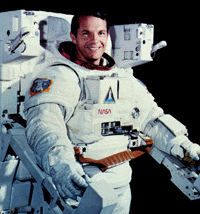 When Robert Stewart first enlisted in the army, he did not imagine his life would be be centered on mathematics. For the beginning of his career, Stewart was a flight instructor and flew helicopters in Vietnam. Then, everything changed when he was sent to the Army’s Guided Missile Systems Officer Course, a program centered around applied mathematics.
When Robert Stewart first enlisted in the army, he did not imagine his life would be be centered on mathematics. For the beginning of his career, Stewart was a flight instructor and flew helicopters in Vietnam. Then, everything changed when he was sent to the Army’s Guided Missile Systems Officer Course, a program centered around applied mathematics.
“Laplace transforms became tools for stability and control analysis, not mathematical abstractions, Calculus of Variations became means for computing optimum flight profiles.” said Stewart. “ In short, the mathematics took on a concrete reality.”
Stewart went on to complete his Masters degree in aeronautical engineering at the University of Texas at Arlington, then went on to the US Naval Test Pilot School. While at the school, he made a daily journey from the abstract to the physical, starting with exploring equations in the morning classes, then watching those same equations demonstrated in the air each afternoon. The relationship between mathematics and the real world became forever cemented together.
While working as an experimental test pilot in California, Stewart tested five prototype helicopters, including an Apache attack helicopter. “The ultimate test of a mathematical analysis is to bet your life on it by flying an aircraft that isn’t quite ‘housebroken’ yet,” said Stewart. In both military and civilian experience, Stewart has logged approximately 6,000 hours of flight time, and handled 38 different types of airplanes and helicopters.
As if taming helicopters wasn’t enough, Stewert became a NASA Astronaut and flew two space shuttle flights. On his mission on the STS-41B Challenger, in February of 1984, Stewart was the first Army astronaut to walk untethered in space. He did so when performing first orbital flight tests of the Manned Maneuvering Unit, a propulsion device that allowed astronauts to move through outer space while the spacecraft was still in flight.
“Being all alone, 1,000,000 feet above the earth, traveling at nearly 17,500 mph, makes one very happy that Isaac Newton and Johannes Kepler were steadfast in their pursuit of mathematics,” said Stewart.
Stewart went on to become Director of Advanced Programs at the Nichols Research corporation in Colorado Springs in 1992. He was inducted into the Army Aviation Hall of Fame in 2007.
“It should be evident that each step in my career has rested on a firm foundation in mathematics,” he said. “For me, the study of mathematics was the key that opened the doors to the universe.”

